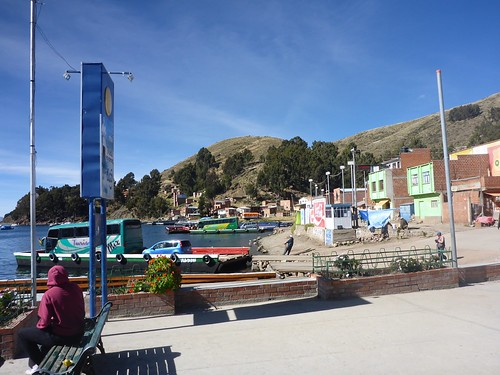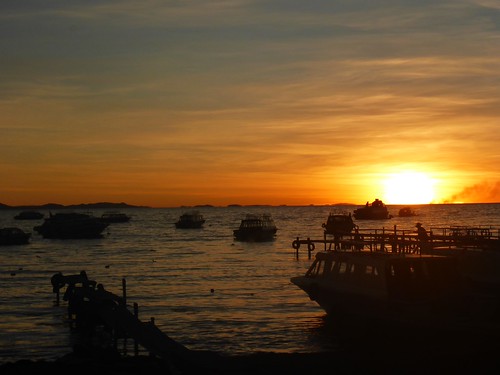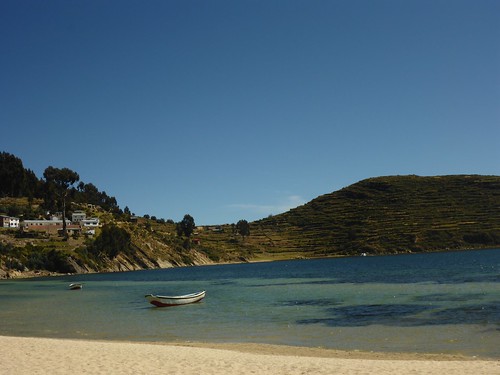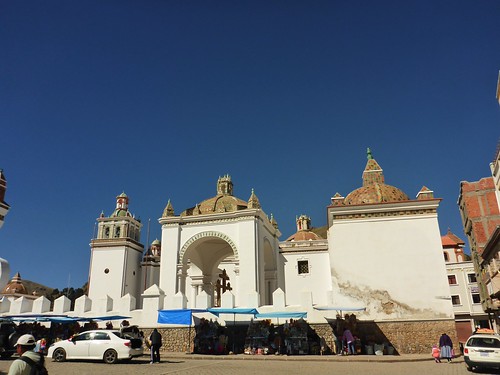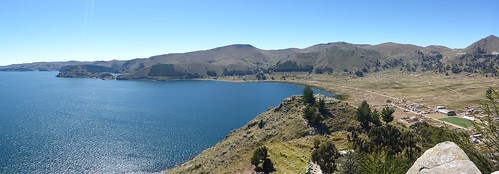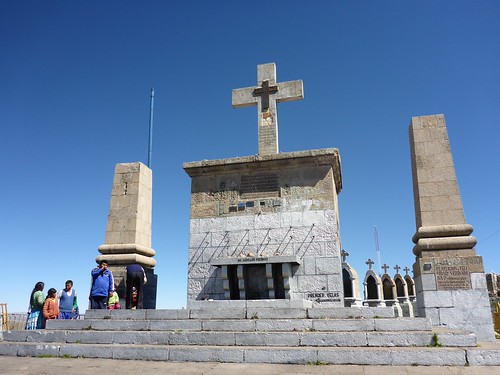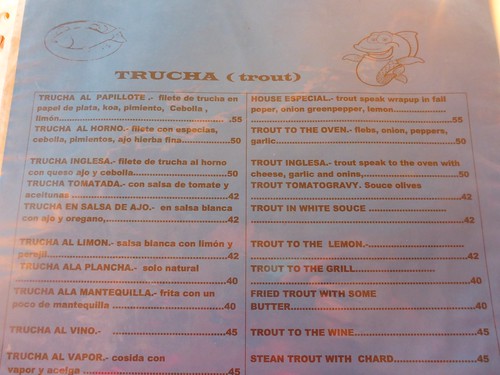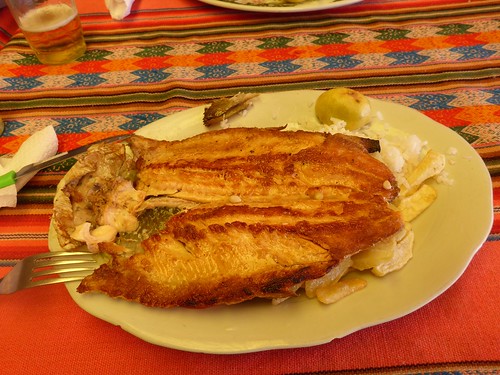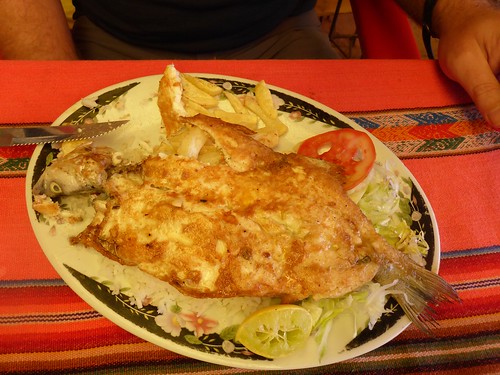¡Hola! Copacabana, we’re still not quite North of Havana, or in Brasil, but we are still in Bolivia!
Known for its fantastically cooked freshwater trout, as well as lots of religious celebrations, Copacabana is a small town nestled against the shore of Lake Titicaca and is one of the smallest places we are likely to visit, with a whopping population of 6000 people. The name Copacabana is from the Aymaran phrase “kota kowana” and means “view of the lake”. Initially inhabited by the Incas, this little lakeside town is the original Copacabana, lending its name to the famous beach in Rio.
Lake Titicaca is the largest lake in South America and is highest navigable lake in the world, sitting at 3812m above sea level. The lake has a surface area of 8372km2, is home to six islands, holds nearly 900 cubic metres of water and has a maximum depth of 281m, in short it is massive!
Catching the bus in from La Paz we wove around a huge number of hills to get to a small river crossing in the middle of nowhere. The everyone on the bus piled onto a tiny boat, while the bus itself was put onto a dodgy looking barge and transported to the other side. Waiting for the bus to cross we stopped briefly and bought a few snacks, risking our lives (or stomachs as it were) with a bit of street food.
Weaving a little more through mountains and around the lake, we arrived into Copacabana mid-morning and found our way up to the hostel. We learnt that one should look at the topology of towns before booking really cheap hostels that appear to be walking distance from the main street. With around 20kg of luggage each, at 3841m above sea level, the one kilometre walk up the giant hill wasn’t an easy ten minutes; the walk may have been filled with a small amount of choice language.
After recovering from the walk and settling into our hostel we headed back down toward the lake we met up with Josh and Kristy for lunch and then wandered around the to find ourselves a tour to Isla Del Sol. Like any other tourist place, you couldn’t walk two metres down the street with out being chased down by someone trying to sell you a key ring, a tour, a llama jumper or jamming a menu in your face at any hour of the day; even if they just saw you eat and walk out of another café. After getting the few jobs that we needed finished, we eventually settled in at a café for the afternoon down near the waterfront for some of their two-for-one cocktails. We got to know the owner Barto, from Chile, and spent the afternoon watching the beautiful sunset over the water, complete with Pisco Sours. A few too many of these later we had a late dinner at ‘La Orilla’ and ordered ourselves an extra hot and extra delicious chicken curry, washed down with a glass (or five) of wine.
Our hostel wasn’t bad to stay in, though the ‘features’ listed on Hostelworld and what the hostel had available didn’t quite match up. Our cement like bed and lack of curtains in the room made for an earlier start than intended on Friday morning, coupled with the lack of breakfast that was supposed to be provided and cold coffee, it was a bit of a rough morning. Deciding we might be able to do breakfast ourselves, we investigated the “kitchen”, a 1.5mx1.5m room with a portable gas cooktop on a rickety wooden table, no fridge, and a laundry sink… we opted for breakfast downtown instead. We needed to be at the wharf near the town’s white anchor by 7:45am to catch our boat across to Isla Del Sol, arriving a little late we were both worried that we might have missed the boat… forgetting that of course, it’s South America – we departed half an hour later than we were supposed to.
Isla Del Sol, “Island of the Sun”, is situated on the Bolivian side of Lake Titicaca and has a very rough terrain; it is home to a lot of Eucalyptus trees – something we weren’t expecting to see many of in South America. The island has been occupied since 2200BC and is home to a host of historical ruins and artefacts. There are currently around 800 families living on the island with most of its economy relying on tourism, fishing and agriculture.
Three hours on the boat later we arrived at the Northern end of Isla Del Sol, we were given instructions in some rapidly spoken Spanish then sent on our way. We knew we needed to pay a ten Boliviano fee somewhere on the island and that we needed to be back at the boat by 1pm. Confused as to what was going on, we nearly wound up on one of the expensive walking tours (that you could do yourself for free), and couldn’t find the place where we had to pay the fee. Eventually we walked down one of the tiny dirt side streets and were directed into a mud brick hut by a man, who wouldn’t let us pass to the nicer side until we’d been inside the hut – we then found out that was where we needed to pay, we weren’t being accosted, robbed or kidnapped. Armed with tickets and backpacks we were on our way to the nicer part of the island, where Dee stayed at the beach and enjoyed the sunshine. James decided that, although we were at stupidly high altitude, he was going to go for a walk further up the hill to find some religious monuments – nothing is signed on the island and he was given some very vague directions. About an hour later James returned, unsuccessful in his quest to find the monuments, hot and irritated… He should have stayed down at the beach. Grabbing a quick drink of cold water then chilling out down near the boat, we ran into Alice, who we’d met at our trip across the salt flats. Whilst chatting and sharing our adventures so far, James managed to get sunburnt on the back of his hands…
Hustled back on to the boat it was time for us to head to the southern end of Isla Del Sol; we did have the option of doing a three hour walk from the northern side to there but we decided against it… the altitude was taking it’s toll. After an hour and a half on the boat we’d arrived, we only had an hour so we decided to walk up the hill and stairs get some lunch, feasting in on a bit of trout, rice and chips. Every meal we’ve had in Bolivia seems to come with a double load of carbs, it’s either rice and chips, pasta and chips, or some kind of chips with another type of potato served with them. We took in the beautiful view from the top of the hill and coupled our meal with a glass of wine and a beer. Not a bad way to spend the afternoon! Back on the boat again, we opted to sit on the top deck this time around as it wasn’t as cold as it had been in the morning. We took in the vastness of the lake and watched as the sun and the little bit of cloud around reflected on the still water of the lake.
As we arrived back to Copacabana we headed to another of the bars that had two-for-one cocktails; this one was a themed football pub called Manchester. This time we watched the sunset from the second floor and enjoyed the nice breeze coming across the lake although, as soon as the sun sets the temperature instantly drops by 5 degrees. It doesn’t seem much but hit with the altitude and a quick temperature change the body goes into a little bit of shock. After sorting out some warm clothes for Dee (who is an absolute wuss with temperatures below 15), we headed up the tourist stretch to see which place would accost first for dinner. Deciding that pizza was the go for the evening, we settled on a place that had a few little less traditional pizzas listed on their menu – including a trout pizza. Strangely, even though Brasil continually claims to have the best pizza in the world, Bolivia has definitely got that title under its belt. A nice thin and crispy base, a good scattering of toppings, generous with the trout and chicken, and not too much cheese to overwhelm the other flavours, we were happy.
Waking to another ridiculous o’clock start because of the beautiful sunshine beaming through our curtain less window, we decided that both of us were in need of a decent coffee. Most of the coffee we’d come across in Bolivia so far has been instant, and although we try not to be picky about it, instant coffee with powdered milk is not a favourite for either of us. Finishing our coffees and another of the standard jam and bread roll breakfasts South America is becoming famous for; we headed up the hill behind our hostel to check out the local markets and the Cathedral.
The Copacabana Cathedral, “Basilica of our Lady of Copacabana”, is one of the oldest churches in Bolivia, it had finished being built in 1576. The cathedral is one of only two primary sacred places that hold importance to both the Indigenous and Catholic communities; it is based at the bottom of Cerro Calvario. Around the outside fences of the Cathedral are street vendors selling incense, wines, candles, rosary beads and many other religious symbols to offer to the image of Bolivia’s patron saint. Above the alter in the cathedral is a statue of Camarin de la Virgen de Candelaria, carved by Francisco Yupanqui in 1583; the statue is reputed to have miraculous healing powers and is one of the many reasons for Bolivians to make the pilgrimage to Copacabana.
Moving on from the Cathedral and the markets we took our time to walk up Cerro Calvario (“Calvary Hill”). From the shoreline you can see a number of crosses up the hill and a shrine stationed on the end. Walking up there are 14 Stations of the Cross, leading to the stations of the “Seven Sorrows of Mary” and then to an altar with a depiction of the Jesus’ crucifixion. Holy Week is the busiest time of the year to walk up this hill, and there are many brick tables around the shrines for people to complete religious ceremonies, there is also the standard collection of ladies selling knick-knacks and candles at the top.
James, struggled with a blocked nose (which seems to be happening a lot on this trip), but half an hour or so later we’d made it to the top, sweaty and dripping off the last bit of sunscreen we’d scraped together. While walking we passed many people praying at the Stations of the Cross, we also passed many older people struggling up the uneven stone blocks to the top – their determination was admirable! The view from the top of the hill was absolutely beautiful, we looked down onto the Copacabana town and then on the right were able to see a few of the smaller towns close to Copacabana. The Titicaca Lake is large enough that you are able to see the water meet the horizon.
Wandering back down the hill, sufficiently sweaty and nearly out of water, it was time to look for lunch. We’d been recommended a place called Kilometre Zero for drinks and food, it serves breakfast, lunch, dinner and then turns into a nightclub… it also offered two-for-one cocktails all day. We dropped in here for the menu del dia of vegetable soup, trout and fruit salad, coupled with a few Maracuya Sours. The Maracuya Sours are similar to Pisco Sours, but instead use a fruit similar to a passionfruit – they are delicious! After eating enough food to feed a small army, we walked around for the afternoon, people watching and looking at all of the market stalls where the locals sell both imported and handmade goods. Unfortunately we don’t have much in the way of space to buy souvenirs, and after investigating the price of sending things back home we decided against post – it is close to $15 to send a package less than 100g from Bolivia, and that’s providing customs don’t get a hold of it and charge duties and taxes! A little exhausted and suffering from a lack of sleep it was time for an early night, and hopefully a sleep-in that didn’t involve church bells and a howling dog, or a rooster crowing at 3am.
Hooray for packing day! Neither of us has been particularly happy about packing every three to four days but I guess that’s the joy of travelling right? Managing not to have an argument about who needs to pack what and in what order, we handled the last few jobs we could get done on the dodgy hostel internet. We popped our bags into the storage area and eventually got ourselves organised enough for breakfast. We took our time taking a last little look around town and getting a few more photos of bits and pieces.
Along the edge of the lake there are a myriad of little tent restaurants run by the locals. All of the restaurants have the same menu, just in slightly different colours – the specialty here is trout, which you can order in almost every way imaginable. Many of the menus here have pictures to help out the non-Spanish speakers who visit the town, or they have an “English” version of the menu. Both of us can competently read and understand the Spanish menus but have asked occasionally for the English translation for a laugh more than anything else – the English menus have become very difficult to read in some places, Google Translate is not always the most reliable source of translations. One hilarious example we came across was in one of the tents advertising their house special: “House Especial. – trout speak wrapup in fail poper, onion greenpepper, lemon”. The wrapup in fail poper did look quite good but we instead opted for ‘trucha a la plancha’ (grilled trout) and ‘trucha del diablo’ (literally translated as trout of the devil – it is grilled trout with chilli). Being in Bolivia these obviously came with both chips and rice, as well as a giant container of salsa picante (spicy sauce), and a sugary drink made from some kind of mystery fruit. Our meals together cost a total of $2aud and were great value. If any of you reading this come to South America, please don’t be scared by the dodgy looking street restaurants, many of the councils have made it easier for locals to sell their food by providing running water and electricity… these little spots have been by far some of the best food we’ve eaten on our trip.
Crawling back up the hill to our hostel to get our bags, it was time to get on the bus to head to Cusco. Once we had ourselves sorted and settled on the Bolivia Hop bus we headed toward the border to Peru. It was time for another border crossing! The guide on the bus was fantastic but was slightly confused when Dee asked about taking food and drinks across the border. Having not travelled much over borders on buses, and some places physically inspecting and x-raying bags, as well as having food and drinks confiscated, Dee thought it wise to ask what we were allowed to carry across. The guide took it as a joke and made a bit of fun at us; then we explained that we can’t take fruit between states in Australia and that it was a genuine question. The border between Bolivia and Peru was much more relaxed than others that we’d experienced.
Changing buses at the border and checking out the pimped up tuk-tuks we arrived into Peru!
Go see all the photos from Copacabana and Isla del Sol

